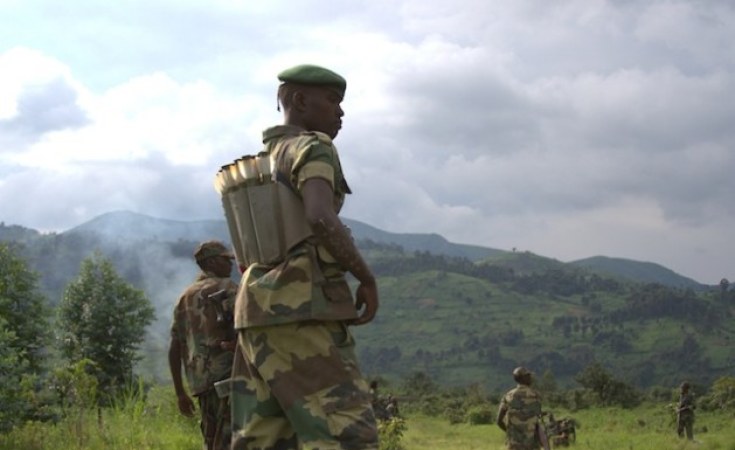Nturo Village, located in Masisi, North Kivu province in eastern DR Congo, is a Tutsi community that was attacked and burned down in October 2023. The massacre, which resulted in the destruction of 300 homes and the deaths of several civilians, was reportedly carried out by the Congolese army, the Rwandan genocidal militia FDLR, and local groups known as Wazalendo.
Survivors of the attack have pointed to the with the complicity of Burundian forces in the brutal violence that happened a few kilometres from their base.
ALSO READ: Scholar tells how Burundi, FDLR connived in DR Congo village massacre
According to the survivors who spoke to the journalist Teddy Mazina, the attack was planned and carried out under the watch of Burundian forces, who had previously served under the East African Community Regional Force.
Initially, residents were unaware of the collaboration between Burundian forces and the assailants. During the attack, they sought refuge from their bases, only to be turned away.
Niyongabo Gishaja, a survivor of the massacre, recounted fleeing with his wife and four children. He described how government forces, along with the FDLR, Mai Mai Nyatura militias controlled the area, targeting the Tutsi community and destabilizing them long before the attack.
"The Congolese army and its allied militias surrounded us, keeping us in the center. When the Burundian forces arrived, they claimed to be here to protect civilians. But instead of ensuring security, they facilitated the massacre," Gishaja told Mazina.
"They established military bases in Petit Masisi and another on a nearby hill, supposedly to protect civilians. There are trenches where Burundian troops were stationed--you can still find them there. When we were attacked, we ran to them for shelter, but they refused to help. They told us, 'We cannot hide you; we cannot offer any help because the people attacking you are our soldiers.' They denied us any form of assistance,"' he recalled.
ALSO READ: DR Congo crisis: Banyamulenge villages in South Kivu attacked again
With no other options, the fleeing villagers scattered and hid wherever they could. When the violence subsided, they returned home--only to witness the full scale of the destruction.
"After returning to our homes, we were attacked again. The real massacre unfolded--people were burned alive inside their houses, bombed, and brutally killed. They killed people, set houses on fire, and looted everything--livestock, household items. Not a single possession was spared. We lost everything," he explained.
ALSO READ: DR Congo crisis: Who are the three new peace facilitators?
Aline Tuyishime, another survivor, recounted how she desperately tried to seek refuge with the Burundian forces but was turned away. She attempted to force her way into their shelter, unable to comprehend why they refused to help.
Standing in the grassy area, where her demolished house used to be, Tuyishime described her ordeal.
"The Burundian forces refused to hide us, and I couldn't understand why. As gunfire rang out all around us, I tried to force my way into their caves, but they told us not to seek refuge there. Instead, they said we should go to our brothers (M23). Meanwhile, people were being slaughtered, and houses were set ablaze," she said.
"They pumped petrol all over the houses and then set them on fire. That's how they managed to burn everything down so quickly," Tuyishime explained.
ALSO READ: Rwanda's concerns must be addressed along with DR Congo's issues, Kagame says
The aftermath of M23's withdrawal
These attacks occurred six months after M23 had retreated from 80 per cent of its previously controlled territory in Rutshuru and Masisi and one month before the EAC regional forces began their withdrawal from DR Congo.
The withdrawal, which was part of de-escalation efforts, left the Tutsi community vulnerable to violence from Congolese forces and their allied militias.
Starting on October 2, 2023, FDLR forces launched attacks on Nturo for three consecutive days.
The EAC regional force, which included troops from Burundi, Kenya, South Sudan, and Uganda, was first deployed in November 2022 to help restore peace and stability in eastern DR Congo.
However, its mission quickly became complicated. Initially, the regional force worked to facilitate a political solution and protect civilians. By late 2022, M23 had begun withdrawing from captured territories, handing them over to the EAC troops as part of a negotiated peace effort. However, the Congolese government wanted the EAC force to actively fight M23, which was not part of its mandate.
As tensions grew, Kinshasa turned to alternative allies, including Burundian troops, SADC forces, and even European mercenaries to wage war against the M23 rebels.


